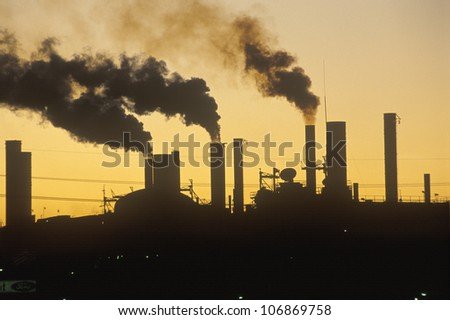Environmental issues and pollutants
There are a lot of environmental issues, which causes damage/harm to the body yet we are unconscious of them...
For example;
Acid rain:
Acidic precipitation (rain, snow, or mist), thought to be caused principally by the release into the atmosphere of sulphur dioxide (SO2) and oxides of nitrogen. Sulphur dioxide is formed by the burning of fossil fuels, such as coal, that contains high quantities of sulphur; nitrogen oxides are contributed from various industrial activities and from car exhaust fumes.
Acid rain is linked with damage to and the death of forests and lake organisms in Scandinavia, Europe, and eastern north America. It also results in damage to buildings and statues. US and European power stations that burn fossil fuels release some 8g/0.3 oz of sulphur dioxide and 3g/0.1 oz of nitrogen oxides per kilowatts hour. According to the the UK department of the environment figures, emissions of sulphur dioxide from power stations would have to be decreased by 81% in order to arrest damage.
Aerosol:
This are particles of liquid or solid suspended in a gas. Aerosol cans contain a substance such as scent or cleaner packed under pressure with a device for releasing it as a fine spray. Most aerosols used chlorofluorocarbons (CFCs) as propellants until these were found to cause destruction of the ozone layer in the stratosphere. Most so-called 'ozone-friendly' aerosols also use ozone-depleting chemicals, although they are no as destructive as CFCs.
Air pollution:
This is the contamination of the atmosphere caused by the regular mistakenly or intentional discharge, of a wide range of a toxic airborne substances. Often, the amount if the released substance is relatively high in a certain locality, so the harmful effects become more noticeable.
)
The cost of preventing any discharge of pollutants into the air is prohibitive, so attempts are more usually made to reduce gradually the amount of discharge and to disperse this as quickly as possible by using a very tall chimney, or by intermittent release.
Antiknock:
This is a substance that's been added to petrol to reduce knocking in car engines. It's a mixture of dibromoethane and tetraethyl lead. It's use in leaded petrol has resulted i. Atmospheric pollution by lead compounds. Children expose to this form of pollution over long periods of time can suffer impaired learning ability. Unleaded petrol has been used in the USA for some years, and is increasingly popular in the UK.
Leaded petrol cannot be used in cars fitted with catalytic converter.
Biodegradable:
It is capable of being broken down by living organisms, principally bacteria and fungi. In biodegradable substances, such as food and sewage, the natural processes of decay leads to compaction and liquefaction,and to the release of nutrients that are then recycled by the ecosystem.
Non biodegradable substances, such as, glass, heavy metals, and most types of plastic, present serious problems of disposal.
Carbon dioxide CO2:
This substance is colourless, odorless, slightly soluble in water and denser than air. It is produced by living things during the processes of respiration and the decay of organic matter, and plays a vital role in the carbon cycle. It is used as a coolant in it's solid form (known as dry ice) and in the chemical industry. It's increasing density contributes to the green house effect and global warming.
Britain has 1% of the world's population, yet it produces 3% of CO2 emissions; the USA has 5% of the world's population and produces 25% of CO2 emissions.
Carbon monoxide CO:
It's colourless and odourless gas formed when carbon is oxidized in a limited supply of air. It's a poisonous constituent of car exhaust fumes, forming a stable compound with haemoglobin in the blood, thus, preventing the haemoglobin from transporting oxygen to the body tissues.
Catalytic converter:
This is a device a device fitted to the exhaust system of a motor vehicle in order to reduce toxic emissions from the engine. It converts harmful exhaust products to relatively harmless ones by passing the exhaust gases over a mixture of catalysts. Oxidation catalysts (small amount of precious palladium and platinum metals) convert hydrocarbons (unburnt fuel) and carbon monoxide into carbon dioxide and water, while three way catalysts (Platinum and rhodium metals) convert nitrogen oxides gases into nitrogen and oxygen.
Air pollution
- Pollutant. Sulphur dioxide SO2.
Sources:
Oil, coal combustion in power stations.
Effects:
Acid rain formed, which damages plants, trees, buildings, and lakes.
- Oxides of nitrogen NO, NO2.
Sources:
High temperature combustion in cars, and to some extent power stations.
Effects:
Acid rain formed.
- Lead compounds
Sources:
From leaded petrol used by cars
Effects:
Nerve poison
- Carbon dioxide CO2.
Sources:
Oil, coal, petrol, diesel combustion
Effects:
Greenhouse effect
- Carbon monoxide CO.
Sources:
Limited combustion of oil, coal, petrol, diesel fuel.
Effects:
Poisonous, leads to photo chemical smog in some areas.
- Nuclear waste.
Sources:
Nuclear power plants, nuclear weapon testing, war.
Effects:
Radioactivity, contamination of locality, cancers, mutations, death.
Over the lifetime of a vehicle, a catalytic converter can reduce hydrocarbon emissions by 87%, carbon monoxide emissions by 85%, and nitrogen oxide emissions by 62%, but will cause a slight increase in the amount of carbon dioxide emitted.
Catalytic converter are standard in the USA, where a 90% reduction in pollution from cars was achieved without loss of engine performance or fuel economy.
Chlorofluorocarbon (CFC):
This is a synthetic chemical that is odourless, nontoxic, nonflammable, and chemically inert. CFCs has been used as propellants in aerosol cans, as refrigerants in refrigerators and air conditioners, and in the manufacture of foam packaging.
They are partly responsible for the destruction of the ozone layer.
In June 1990 representatives of 93 nation's, including the UK and the USA, agreed to phase out production of CFCs by the end of the 20th century.
When CFCs are released into the atmosphere, they drift up slowly into the stratosphere, where, under the influence of ultraviolet radiation from the sun. They break down into chlorine atoms which destroy the ozone layer and allow harmful radiation from the sun to reach the Earth's surface. CFCs can remain in the atmosphere for more than 100 years.
Replacement for CFCs are being developed, and research into safe methods of destroying existing CFCs is being carried out. The European Union has agreed to ban by the end of 1995 a range of CFCs.
Compost:
This is an organic material decomposed by bacteria under controlled conditions to make a nutrients rich natural fertilizer for use in gardening or farming. A well made compost heap reached a high temperature during the composting process, killing most weed seeds that might be present.
Conservation:
This is an action taken to protect and preserve the natural world, usually from pollution, overexploitation, and other harmful features of human activity.
The late 1980s saw a great increase in public concern for the environment, with membership of conservation groups, such as friends of the earth, rising sharply.
)
Globally the most important issues include the depletion of atmospheric ozone by the action of chlorofluorocarbons (CFCs), he build up of carbon dioxide in the atmosphere (thought to contribute to an intensification of the greenhouse effect), and the destruction if the tropical rainforests.
Deforestation:
This is act of destroying forward for timber, fuel, charcoal burning, and clearing for agriculture and extractive industries, such as mining, without planting new trees to replace those lost (reafforestation) or working on a circle that allows the natural forest to regenerate. Deforestation causes fertile soul to be blown away or washed into rivers, leading to soil erosion, drought, flooding and loss of wildlife.
Deforestation can take place in both tropical rainforests and temperate forests.
Desertification:
This can be simply be defined as the creation of deserts (Dry land), by changes in climate, or by human aided processes.
The processes leading to desertification includes; overgrazing, destruction it forest belts, and exhaustion of the soil by intensive cultivation without restoration of fertility. It may be prompted by the pressures of an expanding population, by concentration in land ownership, or by other political conditions forcing people into unsuitable land.
About 135 million people are directly affected by desertification, mainly in African countries, Indian subcontinent, and south America.
References:
https://www.livestrong.com/article/221368-types-of-environmental-pollutants/
https://www.sciencedirect.com/topics/earth-and-planetary-sciences/environmental-pollution
https://www.nrdc.org/stories/air-pollution-everything-you-need-know
Thanks for stopping by to check out my post
Kindly follow me @morahn for more reasonable posts.



Beautifully written and well articulated. Industrialization has played a major role in environmental pollution, now we are looking for solutions to the damages.
Recomendations;
If the priciple you stated above can be strictly followed, living will be more convenient....
But it's not as easy as we think....
Thanks for the contribution...
this FAQ on writing steemstem posts.
 Hey @morahn, some of the paragraphs are just copy-pasted/reworded from sources which you haven't mentioned in the references. This is an act of plagiarism. steemSTEM is strict about plagiarism and won't support any plagiarist. The images used aren't properly cited either and I am pretty sure that they aren't free for commercial use. Please go through
Hey @morahn, some of the paragraphs are just copy-pasted/reworded from sources which you haven't mentioned in the references. This is an act of plagiarism. steemSTEM is strict about plagiarism and won't support any plagiarist. The images used aren't properly cited either and I am pretty sure that they aren't free for commercial use. Please go through
With due respect sir... No word is copy pasted here.... All was digested and rephrased, except words/numbs that cannot be changed...
About the pictures I'll make changes on that on my next post....
Thanks for the guide... And please check back later...
Here are some proofs of plagiarism in your post:
vs.
vs.
vs.